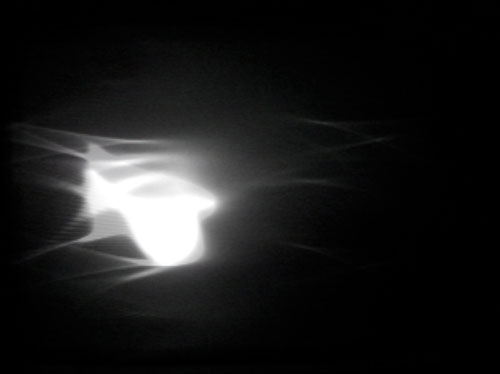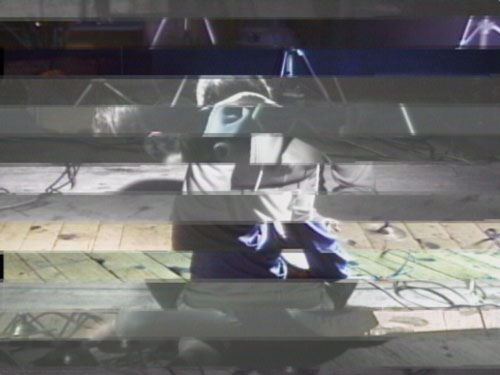November 16th, 2010
The Wobbulator
I was finally able to cobble together a video for Nam June Paik’s Wobbulator. It was one of my favorite pieces of equipment during my residency at the Experimental Television Center, and I was confused about why there wasn’t a lot of information out there about it on the web. There are a few grainy youtube videos but they don’t show a lot of the exterior of the device or any of the real time manipulations, so I wanted to make a little educational video. Most of the Wobbulator’s source images in this video were either from a camera pointed out a window, or just from straight video feedback.
For a lot more information, check out the Experimental Television Center’s website in their Video History Project area. There are tons of great articles on early analog video tools and techniques, but in particular there is a very detailed article on the wobbulator. Just to give you some more info, here is the first paragraph of the article on the device:
A raster manipulation unit or ‘wobbulator’ is a prepared television which permits a wide variety of treatments to be performed on video images; this is accomplished by the addition of extra yokes to a conventional black and white receiver and by the application of signals derived from audio or function generators on the yokes. The unit is a receiver modified for monitor capability; all of the distortions can thus be performed either on broadcast signals or, when the unit is used as a monitor, on images from a live or prerecorded source. Although the image manipulations cannot be recorded directly, they can be recorded by using an optical interface. The patterns displayed on the unit are rescanned; a camera is pointed directly at the picture tube surface and scans the display. The video signal from this rescan camera is then input to a videotape recorder for immediate recording or to a processing system for further image treatment. The notion of prepared television has been investigated by a number of video artists and engineers; this particular set of modifications was popularized by Nam June Paik.
I also made a quick music video with the wobbulator as a key component…check it out here
For more on my experience at the experimental television center check out a few of these links
[1] [2] [3] [4]
This video is now featured on Rhizome, Create Digital Motion, Hack a day, Makezine, Wired and Notcot among others
October 30th, 2010
ETC: Day 4
I feel like I’m starting to run out of steam today. Yesterday felt comparatively productive, but I’m not too upset since I’ve been getting a lot done these past few days. Today I learned one of the last pieces of equipment, a framebuffer that runs off of an old Amiga computer (loaded off two floppy disks). It allows you to store 32 frames in a circular buffer, and you can play the buffer back as a loop and replace certain frames as you go around to make animations. The catch is that it only operates with 16 gray levels and 256 lines of resolution. You can however replace each gray level with a different color if you wish for simple color mapping.
After that, I wandered around town, hit the local candyshop, and tried to clear my head for a little while. There is an amazing, huge bookstore right across the street that primarily sells antique books. I looked through several arithmetic textbooks from the 1800s, one of which had an addition table and a subtraction table (in addition to a multiplication table).
When I came back, I tried another lo-fi bullettime experiment using audio triggers. I spent the rest of the afternoon running my jitter patch in and looping it back around as a source and manipulating the feedback overtop of the source video…but that proved to be a difficult beast to tame. I then turned to reddit to find out if any of my fellow nerds had any interesting ideas for the equipment I hadn’t thought of yet, but I haven’t hit a goldmine yet.
The rest of the night has been trying to get a handle on using the +/- 5V oscillator bank to generate video signals, and then playing more with simple feedback and audio triggers on the wobbulator. No big plans for the last full day tomorrow except to gather some more random source footage and begin to pack up.
October 29th, 2010
ETC: Day 3
Whew..long day..hence making this post after midnight. After another lesson on the Sandin video manipulator and the Jones sequencer, I had a full day ahead of me. After writing last night I made a gigantic feedback loop using 3 monitors, 3 cameras and two computers running skype. The results weren’t that interesting but I achieved about a .5 second delay through the whole system…it was fun to set up at least.
After learning the Jones sequencer, a device which uses an oscillator to switch between 8 different sources, I set to work with a couple projects. The first thing that came to me was to make a sort of lo-fi ‘bullet time’ effect with the 7 cameras available here. At first i set them all up in a semicircle pointing at a central point, and it worked to a point, but the inaccuracies in my pointing ended up throwing it off..but the result looked like a weird kind of slit scan hybrid. Still working on the sync for this one…
Then I spent some time getting more documentation of the Wobbulator. There doesnt seem to be any quality videos of it around the internets, so I’m going to try and cut together a good sample of footage. Got some really nice patterns going today.
I returned to the bullet time concept after trying a few other random experiments. This time I arranged the cameras in a circle around a central point, and this was a little more interesting looking. I got footage of myself walking around and other confusing looking 7-viewpoint images. Then I had an idea for a goofy piece I’ll be calling ‘Drumcircle’
By using a mic as a trigger, I used different drum pieces around the studio to change the viewpoint of the camera as I hit the drums. I did a couple iterations of this piece, with a simple slow, self triggered switch, and a few with automated, oscillator driven camera switches. Hopefully it all works out..I may have to try again tomorrow if I can figure out how to get my audio trigger to be a little more responsive.



9 Comments »